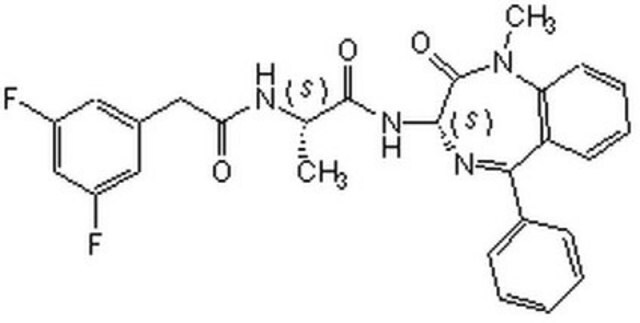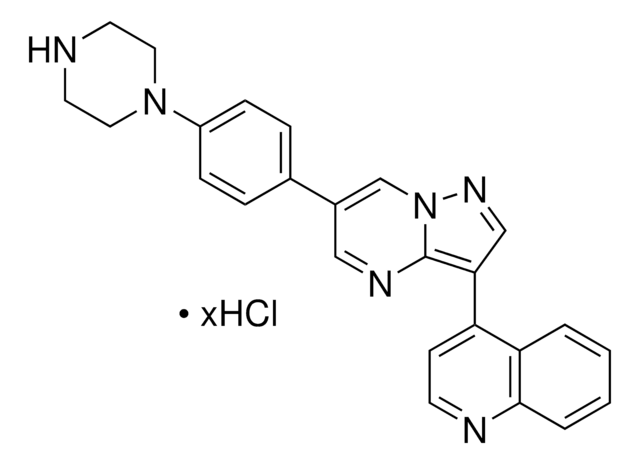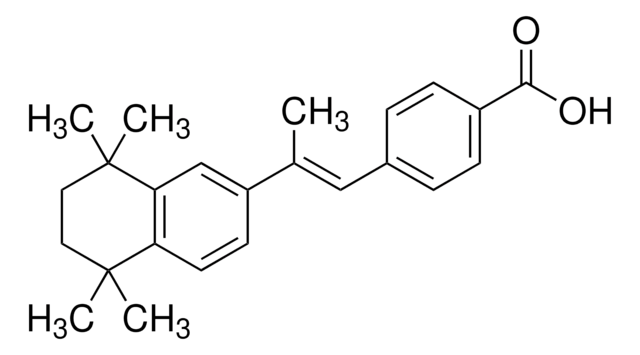524390
Phorbol 12,13-dibutyrate
≥99% (HPLC), solid (crystalline), PKC activator, Calbiochem
Synonim(y):
Phorbol-12,13-dibutyrate, PDBu, PKC Activator II
About This Item
Polecane produkty
Nazwa produktu
Phorbol-12,13-dibutyrate, Strong irritant for mouse skin, but only moderately active as a tumor promoter.
opis
RTECS - EK7767000
Poziom jakości
Próba
≥99% (HPLC)
Formularz
solid (crystalline)
producent / nazwa handlowa
Calbiochem®
warunki przechowywania
OK to freeze
kolor
white to pale yellow
rozpuszczalność
DMSO: 10 mg/mL
Warunki transportu
ambient
temp. przechowywania
−20°C
ciąg SMILES
O([C@]21[C@H]([C@H]3[C@@]([C@H]4[C@](CC(=C3)CO)(C(=O)C(=C4)C)O)([C@@H]([C@H]2OC(=O)CCC)C)O)C1(C)C)C(=O)CCC
InChI
1S/C28H40O8/c1-7-9-20(30)35-24-16(4)27(34)18(22-25(5,6)28(22,24)36-21(31)10-8-2)12-17(14-29)13-26(33)19(27)11-15(3)23(26)32/h11-12,16,18-19,22,24,29,33-34H,7-10,13-14H2,1-6H3/t16-,18+,19-,22-,24-,26-,27-,28-/m1/s1
Klucz InChI
BQJRUJTZSGYBEZ-YVQNUNKESA-N
Opis ogólny
Działania biochem./fizjol.
Na+,K+- ATPase
Opakowanie
Ostrzeżenie
Uwaga dotycząca przygotowania
Rekonstytucja
Inne uwagi
Lee, E.J., et al. 1994. Brain Res. 665, 127.
Critz, S.D., et al. 1993. J. Neurochem.60, 1175.
Iredale, P.A., et al. 1993. Biochem. Pharmacol.45, 611.
Critz, S.D., and Byrne J.H. 1992. J. Neurophys.68, 1079.
Hortelano, S., et al. 1992. J. Biol. Chem. 267, 24937.
Ward C.A., and Moffat, M.P. 1992. J. Mol. Cell. Cardiol.24, 937.
Informacje prawne
Hasło ostrzegawcze
Danger
Zwroty wskazujące rodzaj zagrożenia
Zwroty wskazujące środki ostrożności
Klasyfikacja zagrożeń
Acute Tox. 1 Dermal - Acute Tox. 1 Inhalation - Acute Tox. 2 Oral - Carc. 2 - Eye Dam. 1 - Resp. Sens. 1 - Skin Corr. 1B - Skin Sens. 1
Kod klasy składowania
6.1A - Combustible acute toxic Cat. 1 and 2 / very toxic hazardous materials
Klasa zagrożenia wodnego (WGK)
WGK 3
Temperatura zapłonu (°F)
Not applicable
Temperatura zapłonu (°C)
Not applicable
Certyfikaty analizy (CoA)
Poszukaj Certyfikaty analizy (CoA), wpisując numer partii/serii produktów. Numery serii i partii można znaleźć na etykiecie produktu po słowach „seria” lub „partia”.
Masz już ten produkt?
Dokumenty związane z niedawno zakupionymi produktami zostały zamieszczone w Bibliotece dokumentów.
Klienci oglądali również te produkty
Nasz zespół naukowców ma doświadczenie we wszystkich obszarach badań, w tym w naukach przyrodniczych, materiałoznawstwie, syntezie chemicznej, chromatografii, analityce i wielu innych dziedzinach.
Skontaktuj się z zespołem ds. pomocy technicznej















